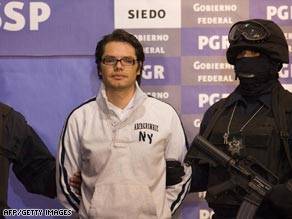
Mexican authorities have arrested Vicente Carrillo Leyva, one of the top leaders of the Carrillo Fuentes drug cartel, officials announced Thursday.
Federal officials offered a reward of up to 30 million pesos ($2.16 million) in late March for information leading to the arrest of Carrillo Leyva. He was arrested in Mexico City, where he had been living under the alias Alejandro Peralta Alvarez, the federal attorney general’s office said at a news conference. Officials said they were able to track him through his wife, who did not change her name. The same reward has been offered for Carrillo Leyva’s uncle, cartel leader Vicente Carrillo Fuentes, also known as “El Viceroy” and “El General.” In addition, $2 million rewards were offered for another 22 leading cartel suspects. Carrillo Leyva’s father, Amado Carrillo Fuentes, died in in July 1997 during plastic surgery to alter his appearance in an effort to avoid capture. He was known as “El Señor de los Cielos,” the “Lord of the Skies,” because of the large fleet of jetliners he used to transport cocaine from Colombia to Mexico. Carrillo Leyva, 32, was presented at the news conference, surrounded by black-clad, hooded law enforcement officials. He wore dark-frame glasses and a white jogging suit with double black stripes on the sleeves. His dark hair was long and shaggy. Wednesday’s arrest was the fourth detention of a suspected top drug cartel leader in recent weeks.
Don’t Miss
Author: U.S. security can’t match Mexican drug cartels
Wanted U.S. marshal’s body found in Mexico
Victim’s wife: Kidnappers’ silence ‘very cruel’
U.S. shares blame for Mexico drug violence, Clinton says
Last week, officials announced the arrest of Hector Huerta Rios, also known as “La Burra” or “El Junior,” a top lieutenant of the Beltran Leyva cartel. He was arrested in the city of San Pedro Garza Garcia in Nuevo Leon state, along Mexico’s border with the United States. The previous week, Mexican authorities announced the arrest of Sigifredo Najera Talamantes, a drug-trafficking suspect accused of attacking a U.S. consulate and killing Mexican soldiers. Talamantes, also known as “El Canicon,” also is suspected of attacks on a television station in Monterrey in Nuevo Leon, the state-run Notimex agency said. The Mexican military also arrested the son of a top drug cartel lieutenant that same week. Authorities on both sides of the U.S.-Mexico border blame drug cartels for a surge in violence in the region. Despite the violence, Mexican officials say the country is generally safe and that tourist areas such as Cancun and Acapulco are heavily patrolled. Officials from the Acapulco city hall and the Guerrero state government,joined by the Mexican attorney general, went so far as to sign a statement in early March assuring students who wanted to go there on spring break that efforts had been taken to ensure their safety. In a speech in mid-March, Mexican President Felipe Calderon said 93 percent of the 6,500 deaths attributed to organized crime in 2008 occurred among the criminals. Most of the rest were law enforcement authorities, officials have said. Few civilians are killed, the president said. In that same speech, Calderon ridiculed those who say Mexico is unsafe. “It is absolutely false, absurd, that anyone indicate that Mexico does not have control over one single part of its national territory,” he said. “I challenge anyone who says that to tell me what part of the country they want to go to and I will take that person there.” Analysts point out that most of the violence is occurring along the U.S. border area, particularly in Ciudad Juarez, Chihuahua and Tijuana. Drug cartel violence is also found on Mexico’s western coast. “The situation in Ciudad Juarez is of special concern,” the U.S. State Department said in a February 20 travel alert. “Mexican authorities report that more than 1,800 people have been killed in the city since January 2008. Additionally, this city of 1.6 million people experienced more than 17,000 car thefts and 1,650 carjackings in 2008.” The State Department advisory tells U.S. citizens how best to remain safe. “While millions of U.S. citizens safely visit Mexico each year (including thousands who cross the land border every day for study, tourism or business), violence in the country has increased recently. It is imperative that travelers understand the risks of travel to Mexico, how best to avoid dangerous situations, and whom to contact if one becomes a crime victim. Common-sense precautions such as visiting only legitimate business and tourist areas during daylight hours, and avoiding areas where prostitution and drug dealing might occur, can help ensure that travel to Mexico is safe and enjoyable.”